How To Install A Ceiling Fan On A Peaked Ceiling
Disclosure: We may become commissions for purchases fabricated through links in this post.
Having a ceiling fan in your domicile is a great way to keep the entire room cool without the costs of running an air conditioner all day. Although it might seem like a formidable task when you're just starting, information technology'southward easy to supervene upon an former lighting fixture with a new ceiling fan if y'all know the correct way to practice it. Still, what if the ceiling is sloped? Are you out of luck? Non necessarily; installing your new ceiling fan on a sloped ceiling tin can be washed more easily than you think!
Here are the steps to installing a ceiling fan on a sloped ceiling:
- Plough the electricity off in the circuit breaker box.
- Remove the one-time ceiling box.
- Purchase a clopped fan with a hanger bar if the fixture is betwixt two ceiling joists.
- Attach the ceiling plate or bracket.
- Buy a fan kit.
- Screw the canopy over the fan box.
- Adhere the fan blades.
- Turn the power dorsum on and test your fan.
Whoa, that's a lot of steps! Don't worry considering, in this article, we will talk over each of these steps in particular. Plus, we volition talk about what tools you will demand and answer other mutual questions on installing a ceiling fan.
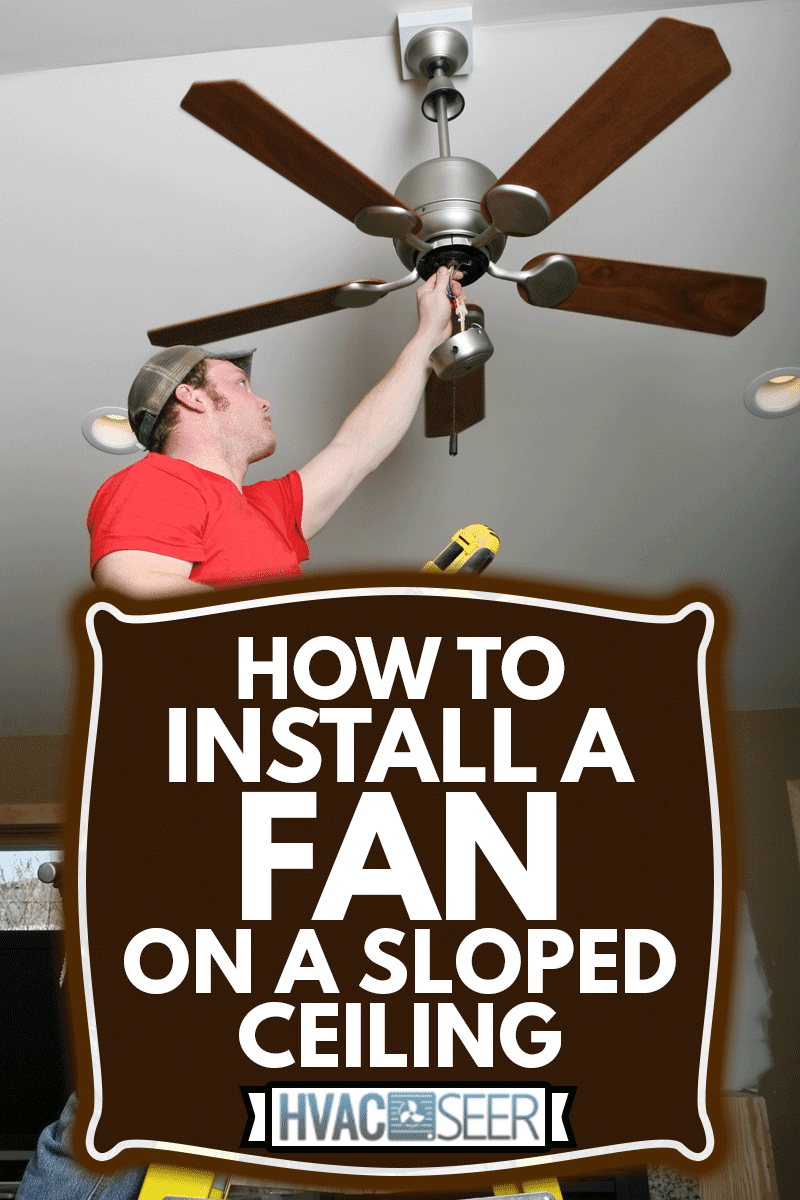
How to install a ceiling fan on a sloped ceiling
Removing the onetime fixture
Turn the electricity off in the excursion breaker box
When working with electricity or wiring, y'all should always cut power to the expanse earlier touching anything else. Locate the circuit breaker box in your home and plough off the power to the room or area your ceiling fan will be installed in.
Some homes will have multiple breaker boxes, with ane main and several sub-breaker boxes in different places. If you take multiple breaker boxes, plow off power at the sub-breaker box and the key box before kickoff work.
Remove any screws belongings the erstwhile fixture in identify
Use a ladder or step-ladder to safely climb up towards the roof to give y'all access to the fixtures. Agree the fixture in place with 1 hand as you remove any screws securing it to the roof. Once they have been taken out, the old fixture should detach from the ceiling on a clopped ceiling fan.
Disconnect the wires from the old electrical fixture
Locate the betoken where the wires from the fixture are held to the wires coming from the ceiling with plastic connectors. Ensure something other than the wires supports the fixture and begin unscrewing and removing each plastic connector. One time disconnected, lower the fixture from your ceiling and discard it or store it somewhere safe for future use.
Remove the erstwhile ceiling box.
The ceiling box is a circular metal fitting that other fixtures attach to. Look for any screws or nails property the old ceiling box in place and remove them. Push the circuit box further into the clopped ceiling, or attempt to pry it out to remove it.
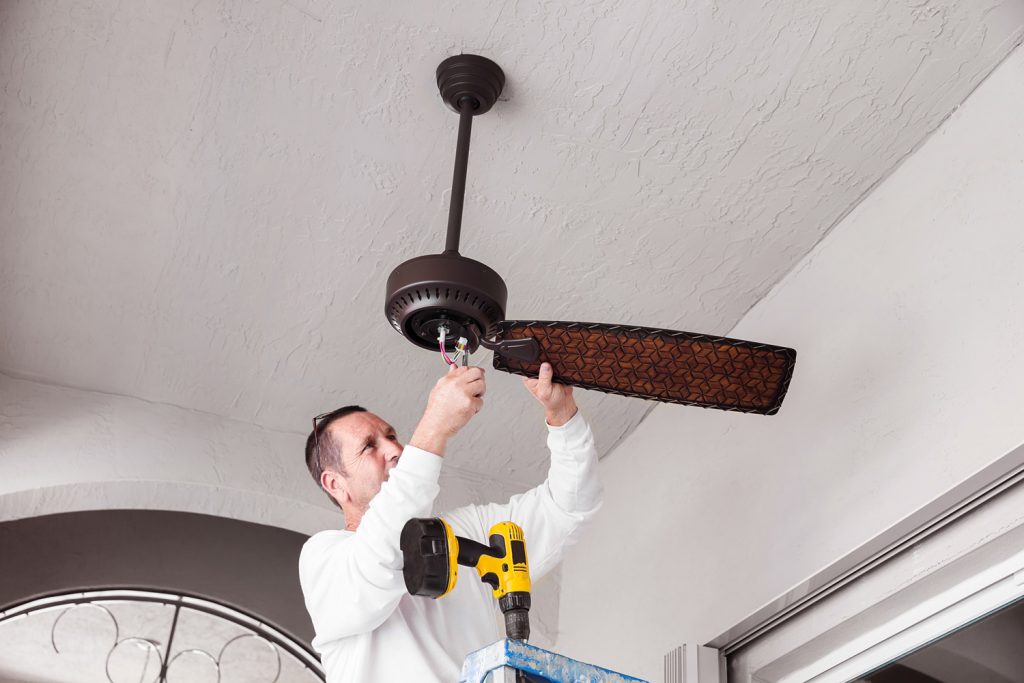
Attaching the new ceiling box
Buy a fan with a hanger bar if the fixture is betwixt ii ceiling joists
A hanger bar is an extendable rod that will hold taut between two ceiling joists and give you something to attach the fan to. Utilise a small flashlight to look into the hole in your ceiling where your new ceiling box will be installed.
If you don't see a long slice of wood directly above the hole, your ceiling box is probable existence installed between two joists. Locate the studs in your ceiling to be sure.
Attach the ceiling plate or bracket
The ceiling plate or fan bracket is the fixture that they volition append your fan from. Concord the ceiling plate up to the fan box and pull all the wires through the pigsty in its center. Utilize the provided screws to secure the ceiling plate in place tightly.
Assembling the Ceiling Fan
Purchase a fan kit
This will contain all the parts you need to assemble and mount a new ceiling fan. Fan kits should be available from your local hardware store, as well as online. Buy a fan that fits the size of the room where information technology will be installed.
Attach the downrod to the fan body
The downrod is the long metal piping that is used to altitude the fan from the ceiling. Keeping the fan's trunk on the ground, thread the wires attached to the fan through the downrod. Sit the downrod in identify on the tiptop of the fan torso. Tighten the locking screws around the base of operations of the downrod until they attached it to the fan trunk.
Elevator the fan upward to the ceiling
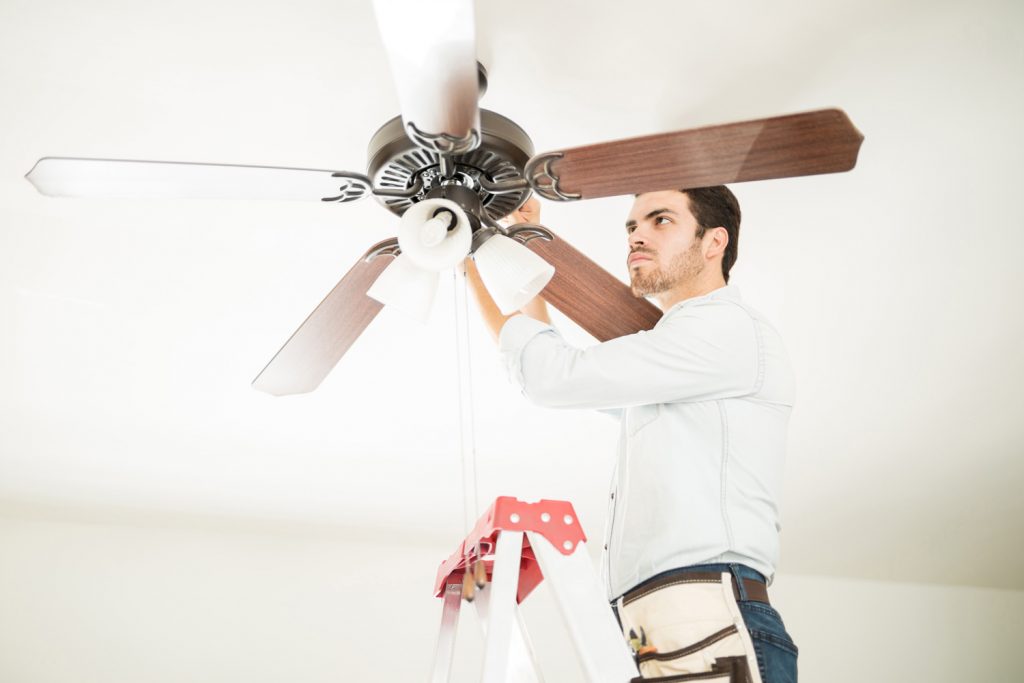
Employ a ladder or stepladder to lift the fan assembly towards the sloped ceiling carefully. Most fans will have some method to suspend them just below the ceiling while you connect the wiring.
Connect the neutral wires
The neutral wire provides a return path for the current coming into the fan and usually has a white insulate covering. Agree the two neutral wires together and twist the stripped ends together. Apply a plastic wire connector to concur them together and secure them with electrical record.
Connect the ground wires
The ground wire will usually be green or entirely bare and is used to prevent electrical shocks. Detect the 2 ground wires, twist them together and secure them with a plastic wire connector. Use electrical tape to go on the wires and the connector in identify.
Connect the remaining wires
Any remaining wires will exist hot wires used to provide power to the fan and whatever light fittings attached to it. These will normally be black but maybe a different color in different wiring schemes. Twist the remaining wires together and secure them with a plastic wire connector and electrical tape.
Tuck the wires into the fan box
Carefully push the wires coming from the ceiling dorsum into the fan box to secure them. Every bit you do, brand sure the wire connectors and electrical tape stay secure, and no wiring is exposed.
Mounting the fan
Screw the awning over the fan box
The awning will elevator from the downrod and cover the wiring and socket used to hold the fan in place. Use the provided screws to secure the awning to the fan box and go on the fan together.
Adhere the fan blades
One by one, lift the fan blades to their mountings on the fan motor. Slot them into identify according to the manufacturer's guide, and use the provided screws to secure them to the motor tightly.
Turn the power back on and test your fan
Go back to the excursion breaker box or boxes and restore power to the sections of your dwelling house. Plough the fan on the wall and watch it for a few minutes to make certain information technology works equally intended.
Volition A Flush Mount Ceiling Fan Piece of work On A Slanted Ceiling?
A affluent mount ceiling fan can work on a slanted ceiling if they have an adapter, and a downrod is used to fit vaulted or sloped ceilings. The adapter and downrod both add peak to the ceiling fan, which may defeat the idea of a flush mountain ceiling fan for your purposes.
How Practise You Mensurate A Ceiling Fan Downrod For A Sloped Ceiling?
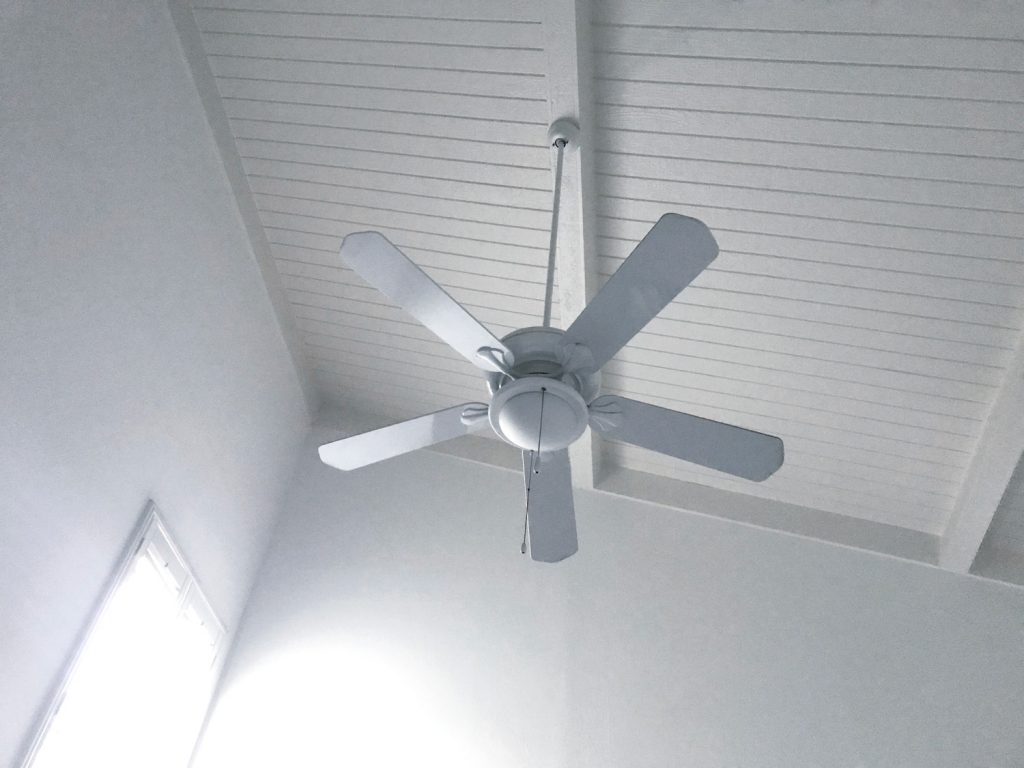
The about common method used to find the right downrod length is to take the ceiling height, subtract the height of the ceiling fan (most fans are between 12 and 18 inches in height depending on the fan), then subtract the desired hanging height (usually 8 feet).
For example, if your ceiling is 12 feet high and your ceiling fan is 12 inches in height, you volition need a 24-inch downrod to mount the ceiling fan between eight and nine anxiety above the floor. You tin can too refer to the downrod length chart below for boosted guidance in selecting the correct measurement.
How Far Should A Fan Hang From The Ceiling?
Ceiling fans should be installed or mounted in the middle of the room and at least vii anxiety above the flooring and eighteen inches from the walls. If ceiling height allows, install the fan 8 - ix feet above the floor for optimal airflow.
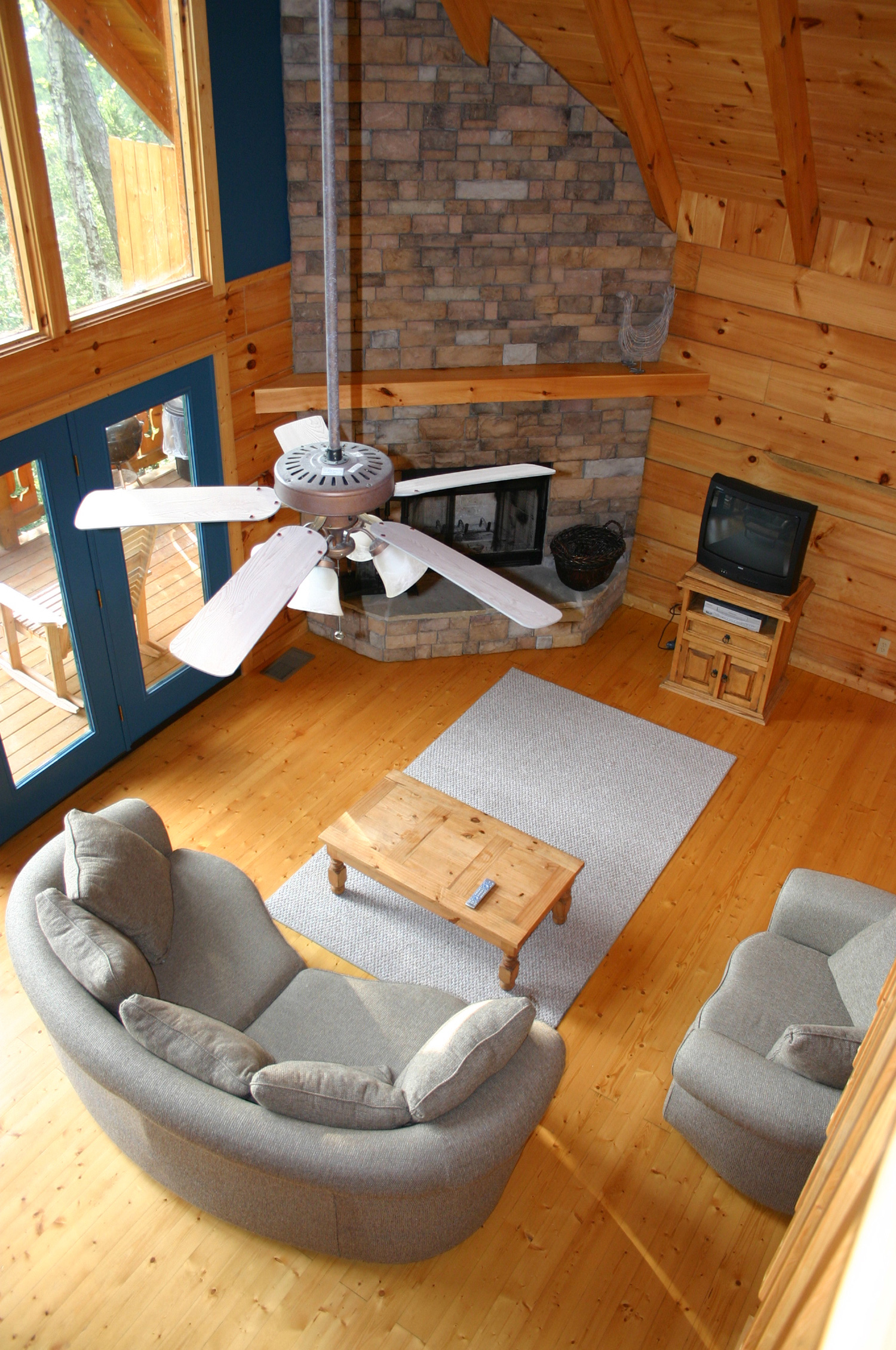
Can Ceiling Fans Be Installed At Any Angle?
For those who desire to install a ceiling fan and have a slightly angled or raked ceiling, don't worry at all! Most (but not all) ceiling fans on the market today can exist installed on a ceiling angled up to 28 degrees with no trouble or any actress accessories needed.
In Endmost
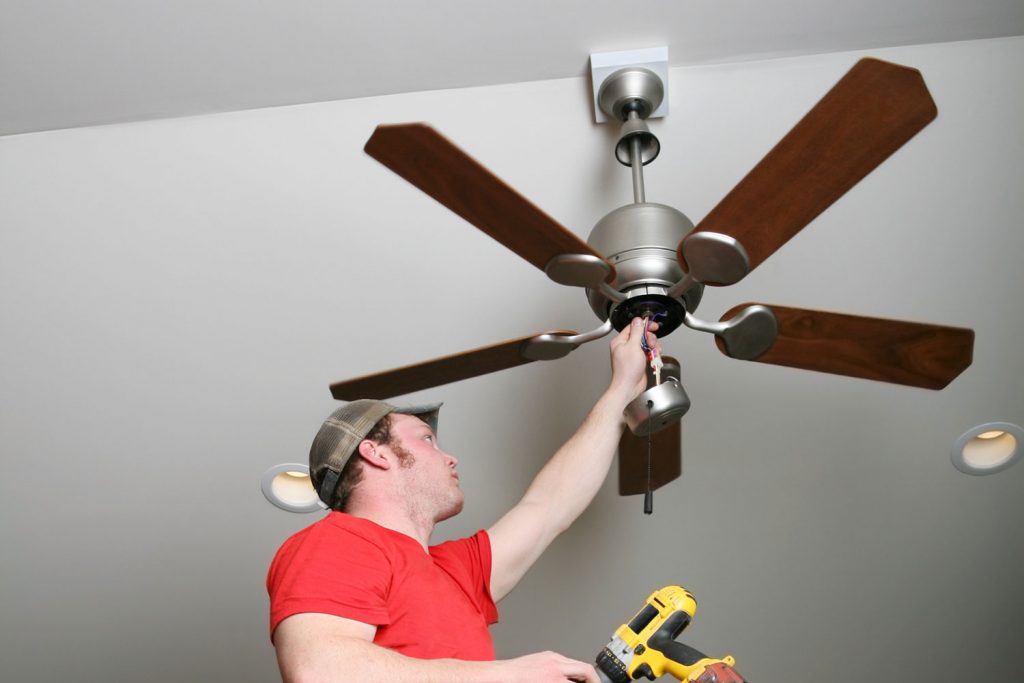
Getting a new ceiling fan in your home tin exist heady, but as you can meet in a higher place, it tin can exist a procedure! What makes information technology even more than difficult is when the ceiling is sloped instead of flat. Even so, it can be done with a little bit of patience.
If y'all enjoyed this article, you might also like:
Practise Cathedral Ceilings Need Ventilation?
Tin Ceiling Fans Overheat?
Source: https://hvacseer.com/install-ceiling-fan-on-sloped-ceiling/
Posted by: mendozaonfor1968.blogspot.com


0 Response to "How To Install A Ceiling Fan On A Peaked Ceiling"
Post a Comment